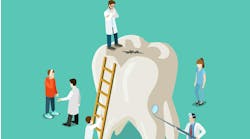Why keeping your patient data in your office is just as silly as saving your money under your mattress
by Andy Jensen
I generally stay away from analogies as a rule. But when it comes to explaining why your patient data is safer on the cloud than on the server in your practice, the following analogy works quite well.
Consider your accumulated wealth. You work hard, save, and invest. Would you feel more or less secure having your nest egg secured with a bank or having it physically in your home? The answer is painfully obvious: It's most secure in a bank.
Why?
Because a bank spends the required resources to secure it. They use monster vaults with substantial locks (the type you just cannot pick easily). Banks also institute best practices and appropriate processes to ensure the safety of your money.
Hired staff has background checks and are trained professionals who specialize in banking security. It is just not feasible to have the same degree of security at home, so you use a bank to secure your wealth.
Does putting your money in the bank make it less accessible? No, quite the contrary. It is more accessible with a bank. You can access it using a check, debit card, wire transfer, or an ATM if you prefer. You do not need to have the cash in your wallet to use it. This further reduces the risk of loss from theft or carelessness.
Just as banks are in the business to secure your wealth, the cloud is designed to secure your data.
Let's take a closer look. Web-based dental software, such as Curve Dental, uses the cloud to secure patient information. The data does not reside in the office. Instead, the data is located in multiple tier-4 secure facilities designed specifically for storage, maintenance, and security of important electronic data.
These facilities cost millions of dollars to build and substantial resources to maintain. Though the practice accesses information using computers in the practice, there is no patient data on any computer in the dental office. It resides at the redundant hosting facilities with several layers of security and backup.
The security present at these data facilities is physical and digital. Physically, the facility's perimeter is secured by fencing and access is restricted only to authorized individuals. Physical pass keys, digital fingerprint scans, photo ID badges, and other recognition technologies are employed to maintain the security of the data inside the facility. If you pay a visit, you will most likely be confronted by security personnel and video surveillance. In short, nobody gets in without the proper paperwork.
Digitally, these facilities implement the best and most expensive software and hardware firewalls to secure the data from unauthorized access. The systems are virtually virus-proof, and are built and managed by the industry's best and brightest software security professionals. Moreover, the data is mirrored in other geographical locations. Should one facility burn or flood or crumble, another picks up where the last left off.
The security of the application should also be noted. With Web-based software, you never install software. Instead, you navigate to a particular website, enter a username and password, and then use the application to manage your practice and secure your patient data. Should the application need to be upgraded, for whatever reason, it can usually be done so without user intervention. In other words, you never hassle with upgrades.
Whenever you log in, the latest tools and features are always available. Outside technical assistance is not required and no production time is lost to upgrades. Upgrades and data backup is a liability with traditional client-server software. This automatic process ensures currency of the application and a certainty that the latest enhancements and fixes are implemented the same day they are available.
And data backup? As I have said, a Web-based system provides the practice with the best business continuity plan ever. Specific to Curve Dental, your data is backed up by the second in multiple locations. If something does go wrong, Curve Dental can deliver a backup of the data down to the last change made to the data.
The overall security plan of a Web-based system is well beyond any dental office in type, scope, depth, function, and expense. You just cannot purchase it any other way. With this background, it is relatively easy to understand how a professionally managed Web-based solution is several orders of magnitude more secure than traditional client-server systems.
A server in a dental practice is subject to natural disaster, user error, and hardware failure. In a matter of seconds, a practice can lose all of its patient data. When this happens, the restoration process can eat up hours or days of valuable production time.
The practice that moves to the Web leaves this worry and hassle behind, knowing patient data is much safer on the cloud than in the practice.
Andy Jensen is the chief marketing officer for Curve Dental, Inc., a developer of cloud-based dental software based in Orem, Utah. He has 20 years of experience in the dental software market. You can reach Jensen at [email protected].
Past DE Issues





